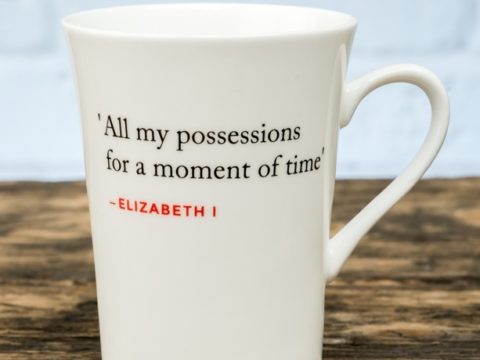Bess of Hardwick: Life Story
Chapter 3 : Debts
Having avoided trouble in 1553, in 1557, Sir William was accused of embezzlement of Crown funds. It was expected that royal officials would cream off a certain level of profit from their positions but the Treasurer, Sir William Paulet, obviously felt that Cavendish had gone too far – and the scale of their land purchases and living expenses suggest that too much money was sticking to Cavendish’s fingers. It was not the first time Cavendish had been accused of false accounting: back in his days of visiting and dissolving monasteries, questions had been raised about a claim for some non-existent expenses.
Bess, who had been in Derbyshire for some time, returned to London whilst William tried to work on his defence. Before he could either be punished or pardoned, William died, leaving Bess a widow for the second time on 25th October, 1557.
Unfortunately, Sir William’s debts did not die with him, and the following spring a bill was brought into Parliament, the substance of which was for the confiscation of the estate to pay the amount of £5,000 that her late husband was accused of misappropriating. The bill was not specific to Bess, but had wider application.
In despair, she wrote to Sir John Thynne, an old friend, from whom she and William had leased a house in Brentford. Whether through the eloquence of Thynne or because the bill would damage too many others, it was not passed. Whilst Bess was still in debt to the Crown, she could try to find another way to deal with the situation.
As 1558 progressed, it became clear that Queen Mary would have no child of her own, and that the next monarch would be the Lady Elizabeth. Whilst Elizabeth was not attached to her Grey cousins, she was part of the wider circle around them, including the Dudleys and Sir William Cecil, who were all friends of Bess. Elizabeth, it may be remembered, had also been godmother to one of Bess’ children. It is likely that during 1558, Bess was spending as much time as possible keeping her relationship with Elizabeth warm, and probably visiting her at Hatfield from time to time.
Mary died on 17th November, and Elizabeth was proclaimed Queen. It is likely that Bess was either at Hatfield or nearby at the time. Soon after, Bess was appointed as a lady-in-waiting. One of the new queen’s other appointees was an acquaintance of Bess, Sir William St Loe (also spelt St Loo, Saintlowe, Sentlowe etc.) He was appointed as the Captain of the Queen’s Guard and Chief Butler.
St Loe, who was around seven years older than Bess, had had a solid career, first as part of the endless English military manoeuvres in Ireland, and then with a place in the household, first of Henry VIII and then Edward VI. On that King’s death, he became one of Elizabeth’s gentlemen. St Loe was a committed Protestant and in 1554 he was sent to the Tower on suspicion of involvement in Wyatt’s Rebellion. Although suspected of passing messages between Wyatt’s men and Elizabeth, he never admitted to anything, and was eventually fined and released.
He was now given his reward. As well as the offices granted by Elizabeth, St Loe held good lands in Somerset. These lands were to be matter of an ongoing dispute between him and his next brother, Edward St Loe.
In July 1559, St Loe and Bess announced their betrothal. They were married on 27th August, either in London, or at the groom’s home of Sutton Court, Chew Magna, Somerset. They were certainly at Sutton Court a few weeks later as the new Lady St Loe gave orders for building works, before the couple returned to the capital.
Building was becoming a passion with Bess. As well as ordering works at Sutton Court, she was continuing the major build at Chatsworth, which was now ready for the decorative plastering that was the fashion of the age.
Before long, the comfortable married life that Bess was settling into with a husband whose letters suggest that he was deeply in love with her, ran into problems. Edward St Loe claimed that his father had told Edward’s second wife, Margaret Scutt, that it should form part of her jointure, but he could produce no documentary evidence. William St Loe suggested a compromise. He would not give up ownership, but Edward and his wife could live at Sutton Court, with Edward acting as Steward. Edward departed, not entirely satisfied, and almost before the dust had settled, Bess fell ill. It was believed she had been poisoned.
William’s thoughts leapt to his brother, and even their mother thought Edward the guilty party. Investigations brought to light a ‘necromancer’, Hugh Draper, who was thought to be Edward’s accomplice. At this point, Bess’ biographers differ. Lovell believes that a cousin of William’s, another Elizabeth St Loe, was confined to the Tower as part of this conspiracy to poison William and Bess, whilst Durant identifies this prisoner quite differently.
There was further argument between the brothers, which resulted in a complex court case, following which, Edward’s wife, Margaret St Loe, nee Scutt, was granted Sutton Court for her life time. Following this, William rearranged his financial affairs to make Bess his main beneficiary. Previously, Bess had been very happy for Edward to be his brother’s heir, but, with the suspicion that he might anticipate nature, and the very ugly wrangling over Sutton Court, it was important for any incentive to be removed.




